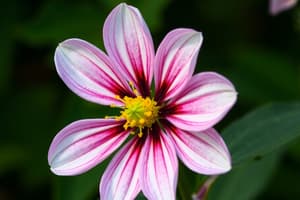Podcast
Questions and Answers
What is the main function of roots in plants?
What is the main function of roots in plants?
- Store pollen
- Absorb water and nutrients from the soil (correct)
- Produce food
- Conduct photosynthesis
Which plant type is characterized by having a single trunk that can grow over 6 meters tall?
Which plant type is characterized by having a single trunk that can grow over 6 meters tall?
- Vines
- Herbs
- Trees (correct)
- Shrubs
What is the primary purpose of sepals in a flower?
What is the primary purpose of sepals in a flower?
- Protect the bud before blooming (correct)
- Promote pollination
- Produce seeds
- Conduct photosynthesis
Which plant morphology feature is responsible for conducting water and nutrients?
Which plant morphology feature is responsible for conducting water and nutrients?
What distinguishes shrubs from herbs?
What distinguishes shrubs from herbs?
Which flower structure is responsible for female reproduction in plants?
Which flower structure is responsible for female reproduction in plants?
Which scientist is credited with devising the binomial nomenclature system for plants?
Which scientist is credited with devising the binomial nomenclature system for plants?
Which of the following lacks specialized tissues like roots, stems, and leaves?
Which of the following lacks specialized tissues like roots, stems, and leaves?
Which kingdom exclusively comprises plants?
Which kingdom exclusively comprises plants?
What type of plants possess specialized tissues like xylem and phloem for water and nutrient transport?
What type of plants possess specialized tissues like xylem and phloem for water and nutrient transport?
Which group of plants includes photosynthetic organisms lacking specialized tissues like xylem and phloem?
Which group of plants includes photosynthetic organisms lacking specialized tissues like xylem and phloem?
What is the primary characteristic that distinguishes algae from plants?
What is the primary characteristic that distinguishes algae from plants?
Study Notes
Exploring the Fascinating World of Plants
Plants are an integral part of our environment, providing food, oxygen, and habitats for diverse life forms. In this exploration, we'll delve into the core features of plants, including their classification, morphology, and the intricate structure of flowers.
Plant Classification
Just like animals, plants are classified into different groups based on their characteristics and evolutionary relationships. The process of plant classification originates from the work of Carl Linnaeus, who devised the binomial nomenclature system, which assigns each plant a unique, two-part name. Plants are broadly divided into two groups:
-
Algae: Simple, photosynthetic organisms living in aquatic or terrestrial environments. They lack specialized tissues like roots, stems, and leaves.
-
Plants: Photosynthetic organisms that are multicellular, have specialized tissues, and reproduce sexually. Plants are further classified into five kingdoms: Monera, Protista, Fungi, Plantae, and Animalia. Plantae is the kingdom exclusively comprising plants.
The Plantae kingdom is further divided into two divisions:
-
Bryophytes: Non-vascular plants that include mosses, liverworts, and hornworts. They reproduce sexually and lack specialized tissues like xylem and phloem.
-
Tracheophytes: Vascular plants that include ferns, conifers, and flowering plants. They possess specialized tissues like xylem and phloem for transporting water and nutrients.
Plant Morphology
The structure of plants is essential for understanding their functions and adaptations. Morphological features can be broadly categorized into three main parts:
- Roots: Absorb water and nutrients from the soil, anchor the plant, and store food.
- Stems: Support the plant, conduct water and nutrients, and store food.
- Leaves: Conduct photosynthesis, produce food, and release water through transpiration.
Plants can be further classified into different forms based on the arrangement of these organs:
- Herbs: Small plants with simple, soft stems and leaves.
- Shrubs: Woody plants with multiple stems that are generally less than 6 meters tall.
- Trees: Large, woody plants with a single trunk that can grow over 6 meters tall.
Flower Structure
Flowers are the reproductive organs of flowering plants, responsible for sexual reproduction. Flowers are typically composed of four main types of structures:
- Sepals: Leaf-like structures that protect the bud before blooming.
- Petals: Attractive, colorful structures that promote pollination.
- Stamens: Male reproductive organs that produce pollen.
- Pistils: Female reproductive organs that receive pollen to produce seeds.
Flower structures may vary among different species, and understanding these differences is vital for determining their evolutionary relationships (phylogeny) and adapting to new environments (ecology).
The Fascination Continues
This is just a brief introduction to the world of plants, where each species offers an array of intriguing features that have captivated scientists, botanists, and nature enthusiasts alike. The more we learn about plants, the more we understand their critical role in maintaining the delicate balance of our environment. So the next time you encounter a plant, remember that you are witnessing one of nature's most extraordinary creations.
Studying That Suits You
Use AI to generate personalized quizzes and flashcards to suit your learning preferences.
Description
Dive into the captivating world of plants by exploring their classification, morphology, and the intricate structure of flowers. Learn about the different groups of plants, essential morphological features like roots, stems, and leaves, and the reproductive organs found in flowers.




